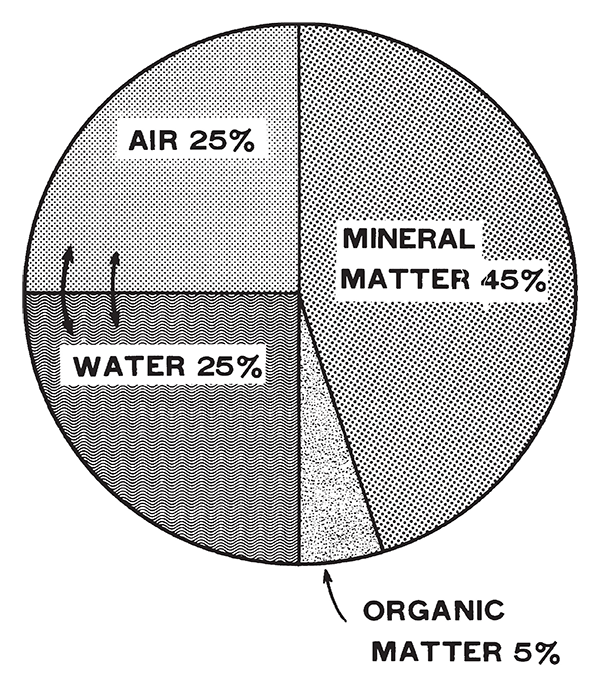Soil is a naturally occurring, loose material at the surface of the earth that is capable of supporting plant and animal life. In simple terms, soil is comprised of three phases: solid, liquid, and gas. The solid phase, which accounts for approximately 50% of the volume in a typical soil, gives soil its mass and is a mixture of mineral and organic matter. Soil particles fit together loosely (depending on particle size and aggregation), leaving “empty” pore spaces. The pore spaces are then filled with water (liquid) and air (gas). The water and air in an average soil make up the other half of the soil’s volume.
All soils are made up of mineral matter, organic matter, air, and water, although the proportions of each will vary. An average soil contains approximately 45% mineral matter by volume and 1 to 5% organic matter. The mineral component is derived from the weathering of rock at the earth’s surface. Mineral particles, which are classified as sand, silt, or clay based on their size, determine the texture of a soil. Weathering of minerals and decomposition of organic matter are key sources of nutrients for life in the soil.
The organic matter component of soil consists of decomposing plant and animal remains. Organic matter acts like glue, binding mineral particles together into aggregates that give a soil structure. Soils high in organic matter do not compress as tightly, meaning they have more pore space. Organic matter also absorbs water, improving the water holding capacity of a soil. Sand like you find in a sandbox does not hold water well because there is no organic matter and the pores between particles are all very large—the water just slips right through.
Pore space occupies approximately 50% of the volume in a typical soil. Water and air, which are both important to soil life, move through the pores in the soil. Larger pores allow air and water to move through the soil quickly, while small pores can hold reserves of air or water. In an “average” soil, half of the pore space is occupied by air and half by water. Of course, these proportions can change drastically during a drought or a flood. During a drought, plants will pull all the water that they can out of the soil, leaving pore spaces filled mostly with air. Water carries nutrients to plants and prevents them from wilting. Extended drought can wreak havoc on farmers.
Somewhat unintuitively, prolonged rain that saturates the soil can also wreak havoc on farmers. When a soil is saturated, all the pore spaces are filled with water, leaving no air. Most crop plants will drown if the soil is saturated for too long—their roots need oxygen from the air just like our lungs do. Some plants have adapted to growing in water. For example, rice has developed a special way to transport oxygen from its leaves to its roots. Rice is often grown in flooded fields, where soil saturation prevents weeds from growing.
 Divide students into pairs. Give each pair a soil sample. Ask students to pour their sample out onto a newspaper.
Divide students into pairs. Give each pair a soil sample. Ask students to pour their sample out onto a newspaper.